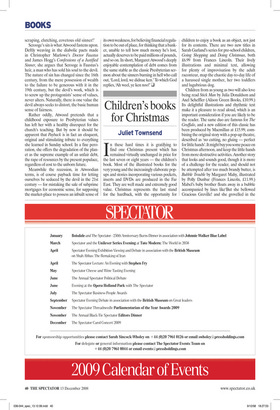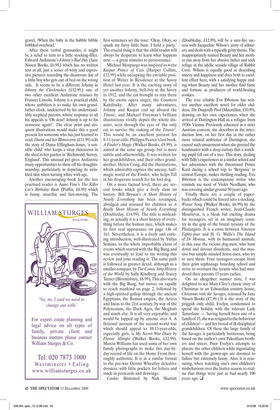Children’s books for Christmas
Juliet Townsend
In these hard times it is gratifying to find one Christmas present which has remained virtually unchanged in price for the last seven or eight years — the children’s book. Most of the illustrated books for the very young and the increasingly elaborate popups and stories incorporating various pockets, inserts and DVDs are produced in the Far East. They are well made and extremely good value. Christmas represents the last stand for the hardback, with the opportunity for children to enjoy a book as an object, not just for its contents. There are two new titles in Sarah Garland’s series for pre-school children, Going Shopping and Doing Christmas, both £6.99 from Frances Lincoln. Their lively illustrations and minimal text, allowing for plenty of improvisation by the adult raconteur, map the chaotic day-to-day life of a harassed single mother, her two toddlers and lugubrious dog.
Children from as young as two will also love being read Stick Man by Julia Donaldson and Axel Scheffler (Alison Green Books, £10.99.) Its delightful illustrations and rhythmic text make it a pleasure to read aloud, which is an important consideration if you are likely to be the reader. The same duo are famous for The Gruffalo, and a new edition of this classic has been produced by Macmillan at £15.99, combining the original story with a pop-up theatre, described as ‘no cutting, no gluing — perfect for little hands’. It might buy you some peace on Christmas afternoon, and keep the little hands from more destructive activities. Another story that looks and sounds good, though it is more of a challenge for the reader, and should not be attempted after too much brandy butter, is Bubble Trouble by Margaret Mahy, illustrated by Polly Dunbar (Frances Lincoln, £11.99.) Mabel’s baby brother floats away in a bubble accompanied by lines like‘But she bellowed Gracious Greville! and she grovelled in the gravel, /When the baby in the bubble bibble bobbled overhead.’ After these verbal gymnastics, it might be a relief to turn to a little stocking-filler, Edward Ardizzone’s Johnny’s Bad Day (Jane Nissen Books, £6.99,) which has no written text at all, just a series of witty and expressive pictures recording the disastrous day of a little boy who gets out of bed on the wrong side. It seems to be a different Johnny in Johnny the Clockmaker (£12.99,) one of two other excellent Ardizzone reissues by Frances Lincoln. Johnny is a practical child, whose ambition is to make his own grandfather clock, undeterred by his understandably sceptical parents, whose response to all his appeals is ‘Oh dear! Johnny is up to his nonsense again!’. The clear print and eloquent illustrations would make this a good present for someone who has just learned to read. Diana and her Rhinoceros (£11.99) tells the story of Diana Effingham-Jones, ‘a sensible child’ who keeps a stray rhinoceros in the shed in her garden in ‘Richmond, Surrey, England’. This unusual pet gives Ardizzone many opportunities to show off his draughtsmanship, particularly in depicting its wrinkled skin when turning white with age.
Another encouraging book for the less practised reader is Anne Fine’s The Killer Cat’s Birthday Bash (Puffin, £8.99) which
070323 3/4/07 11:15 AM Pge 1 070323 3/4/07 11:15 AM Pge 1
is funny, anarchic and fast-moving. The first sentences set the tone: ‘Okay, Okay, so spank my furry little bum. I held a party.’ The crucial thing is that the child reader will always be desperate to learn what happens next — a great stimulus to perseverance.
Michael Morpurgo was inspired to write Kaspar Prince of Cats (Harper Collins, £12.99) while occupying the enviable position of Writer in Residence at the Savoy Hotel last year. It is the exciting story of yet another Johnny, bell-boy at the Savoy in 1912, and the cat brought to stay there by the exotic opera singer, the Countess Kandinsky. After many adventures, Johnny and Kaspar end up aboard the Titanic, and Michael Foreman’s brilliant illustrations vividly depict the whole disaster, seen through the eyes of ‘the only cat to survive the sinking of the Titanic’. This would be an excellent present for 8-11-year-olds. Philippa Pearce’s last book, A Finder’s Magic (Walker Books, £9.99), is aimed at the same age group, but is more subtle and otherworldly. It was written for her grandchildren, and their other grandmother, Helen Craig, did the illustrations, which admirably capture the uneasy, halfmagic world of the Finder, who helps Till in his desperate search for his lost dog.
On a more factual level, there are several books which give a lively slant on history. Bill Bryson’s A Short History of Nearly Everything has been revamped, abridged and reissued for children as A Really Short History of Nearly Everything (Doubleday, £14.99). The title is misleading, as actually it is a short history of everything before the human race, which makes its first real appearance on page 146 of 161. Nevertheless, it is a lively and enticing introduction, well-illustrated by Yuliya Somina, to the whole improbable chain of events which started with the Big Bang and was eventually to lead to my writing this review and your reading it. The same path is followed in greater detail, although in a smaller compass, by The Comic Strip History of the World by Sally Kindberg and Tracey Turner (Bloomsbury, £6.99). This also starts with the Big Bang, but moves on rapidly to reach mankind on page 2, followed by a high-spirited gallop through the ancient Egyptians, the Roman empire, the Aztecs and Incas to the 21st century, by way of the Polynesians, the Dark Ages, the Moghuls and much else. It is all very enjoyable, and would be lapped up by anyone over 8. A fictional account of the second world war which should appeal to 10-13-year-olds, especially girls, is My Secret War Diary by Flossie Albright (Walker Books, £12.99). Marcia Williams has used some of her own family photographs to make this day-byday record of life on the Home Front thoroughly authentic. It is in a similar format to the pre-war Dennis Wheatley detective dossiers, with little pockets for letters and stuck-in postcards and drawings.
Cookie, illustrated by Nick Sharratt (Doubleday, £12.99), will be a sure-fire success with Jacqueline Wilson’s army of admirers, and deals with a typically gritty theme. The inappropriately named Beauty and her mother run away from her abusive father and seek refuge in the idyllic seaside village of Rabbit Cove. Wilson is equally good at describing misery and happiness and does both to excellent effect here, with a satisfying happy ending when Beauty and her mother find fame and fortune as producers of world-beating cookies.
The ever reliable Eva Ibbotson has written another excellent novel for older children, The Dragonfly Pool (Macmillan, £10.99), drawing on her own experiences when she arrived at Dartington Hall as a refugee from 1930s Vienna. Previously educated in a strict Austrian convent, she describes in the introduction how, on her first day in the rather more relaxed ambience of Dartington, she caused such amazement when she greeted the headmaster with a deep curtsey that a watching pupil fell out of a tree. This story, dealing with Tally’s experiences at a similar school and her adventures with the threatened Prince Karil during a school trip to ‘Bergania’ in central Europe, makes thrilling reading. Eva Ibbotson is the contemporary writer who reminds me most of Violet Needham, who was covering similar ground 50 years ago.
Finally there are a couple of paperbacks which could be forced into a stocking. Winter Song (Walker Books, £6.99) by the distinguished French writer, Jean-Claude Mourlevat, is a bleak but exciting drama for teenagers, set in an imaginary country in the grip of the brutal tyranny of the Phalangists. It is a cross between Nineteen Eighty-four and H. G. Wells’s The Island of Dr Moreau, with its humanoid animals, in this case the vicious dog-men, who hunt down and devour dissidents, and the massive but simple-minded horse-men, who try to save them. Four teenagers escape from their grim orphanage boarding school and strive to overturn the tyrants who had murdered their parents 15 years earlier.
On an altogether sunnier note, I was delighted to see Mary Clive’s classic story of Christmas in an Edwardian country house, Christmas with the Savages, reissued by Jane Nissen Books (£7.99.) It is the story of the priggish only child, Evelyn, condemned to spend the holiday with the tolerant Lady Tamerlane — ‘having herself been one of a family of 15, she was resigned to the behaviour of children’— and her brood of ill-disciplined grandchildren. Of these the large family of the Savages is particularly boisterous, being based on the author’s own Pakenham brothers and sisters. Poor Evelyn’s attempts to placate the other children while ingratiating herself with the grown-ups are doomed to failure but extremely funny. Also, it is reassuring, when watching one’s own children’s misbehaviour over the festive season, to realise that things were just as bad nearly 100 years ago. ❑











































































 Previous page
Previous page